I knew if I was going to take a shot at truly exploring how my neighborhood has changed over the years, I’d have to talk to some trusted old heads.
Defining a picture in your mind of what a place was like before you experienced it first hand is what I am aiming to do. This is what books and photos do; but the most valuable to me are the personal stories and perspectives from trusted acquaintances.
Data tells a story too, one that is undeniably accurate and void of opinion and subjectivity. But the written and told stories are beautiful and at times gut wrenching. These stories are life affirming to me, and fill in some of the gaps in our past that data analyses will not.
Right or wrong, the stories and constant explorations of my city are the soundtrack of my life and experience in St. Louis. What better way to attempt to frame our short lives and experiences, than by talking and sometimes drinking with folks who have a wider arc of perspective on a given place.
I need to hear stories about the past to help frame my last ten years in Fox Park.
Was the neighborhood a better place when it was built, how about a generation later during the Great Depression, how about after WWII when it started to empty out, or how about the 1970s when it was on the back end of an industrial/residential mix, or the 1990s when crack cocaine hit this part of the city hard. How about the post-crack years when a few of the gangs/dealers still lived here and the first round of rehabbers came. How about now?
Here we’ll focus in on the late 1970s/early 80s in Fox Park. This is a time of the rebounding neighborhoods in St. Louis that I hold dear, there is so little documentation on the “rock bottom” years in St. Louis.
I wanted to capture some of the stories of the days before I was in St. Louis, the 1970s through the 1990s.
My mind immediately went to Chris Barton, a resident of Fox Park since 1979. I met Chris years ago when I was a member of the Fox Park Park Committee and started attending Neighborhood Association meetings, where Chris was the treasurer.
I wanted to get an understanding of whether longtime residents of Fox Park see the neighborhood as gentrified and/or exclusive to the upper middle class in 2020.
Some readers already made up their minds…if a neighborhood has an association and a park committee, son, it’s gentrified. When houses are selling for upwards of $300,000, it is gentrified. When a place used to be working class and is now attracting a middle class not from here, does it deserve the tag of “gentrified”.
Chris helped frame my perspective, and hopefully his take will broaden your understanding of this neighborhood over the years.
First a little on Chris.
He is one of the kindest, most talented, humble people I’ve had the pleasure to get to know through those neighborhood endeavors years ago. Chris can come across as quiet in group settings and I like that. Quiet people usually have the good stories and are the ones I want to listen to. I’m drawn to them more than the blowhards and pontificators…Chris ain’t that, kind readers.
He’s a humble, soft-spoken soul who’s stories and perspective I trust implicitly.
He has the true mind of an engineer, a former employee of McDonnell Douglas, later Boeing, finally retiring from GKN Aerospace. Not only did he work on F-4s, F-15s, F-18s, C-17 and helicopter parts, etc., he can fix lawnmowers, cantankerous VW’s, rototillers, you name it. He grows shiitake and oyster mushrooms from spawn he raises and propagates in a community garden.
Dude is smart, in the most practical ways.
I once complained that we were struggling with watering some public milkweed gardens we planted, and he showed up with a self-devised watering system in the back of his Dodge pickup. He’s always been there to help with the toughest projects.
He has been retired since 2014, but his mind still works like a steel trap and he continues to help neighbors out with the little things they are working on.
I was lucky enough to sit down with him first over Busch beers in a Benton Park tavern and later over lunch in Soulard to get his perspective on Fox Park over the last 40 years.
Why two meetings? Well I lost all my notes and some brain cells after that first “interview”. I was sober-headed and more focused upon the second attempt and hope to get it right this time.
I’m thrilled he was willing to share his experiences in Fox Park and how it has changed since he bought his first property here in 1982.
Chris grew up in Mehlville, MO. He grew up listening to ska, reggae and acid jazz on WSIE FM. Pink Floyd, Kiss, Bruce Springsteen and Neil Young were swirling in his head at the time.
He was spending a lot of time at the Lucky Dog Saloon in those days and decided to move to the city to be closer to his friends and frequented places.
At age 21 he bought his first two properties in the Gravois Park Neighborhood and rented them out to pay the bills. He moved to Fox Park, first on Ann Avenue and then Russell Boulevard where he’s been ever since.
“Fox Park was quite hoosier then, and I fit in well.
— Chris Barton
Chris mentioned stories about the old days of Fox Park when it was the Wild West of drug dealing, drag racing, huffers and the like. I feel his take has solidified a personal mystery for me: what St. Louis was like when this fringe neighborhood nearly met its demise sometime in the late 1980s and early 90s when crack cocaine (with a strong chaser of alcohol) was the drug of choice.
Chris’ stories tied in the last remnants of the industrial nature of the neighborhood from the late 1970s when factory workers still lived within walking distance from their jobs.
Fox Park used to be an industrial neighborhood and you could feel it when he moved here.
Renowned architect William B. Ittner, who designed some of our most beautiful schools and other buildings, set up shop here in the 1860s. His family built a brick company here and Ittner built some Italianate houses in the 2600 block of Shenandoah (source). There are others he designed all over the neighborhood.
There were factories of all kinds in Fox Park, and the housing around them were built for the owners and workers in these factories.
Some of the buildings still exist.
One such former factory building at Sidney and Ohio tied into one of Chris’ memories.
This building had been home to a Koken barber supply factory. I was recently at a hotel in Kansas City, MO and saw a chair on display.
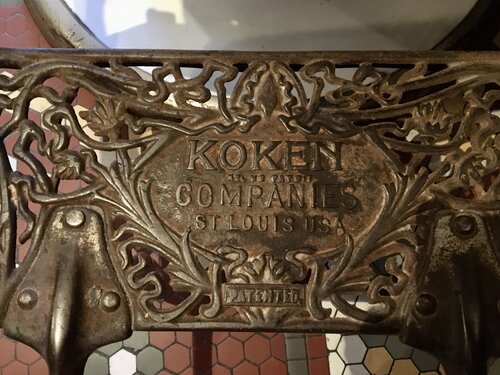
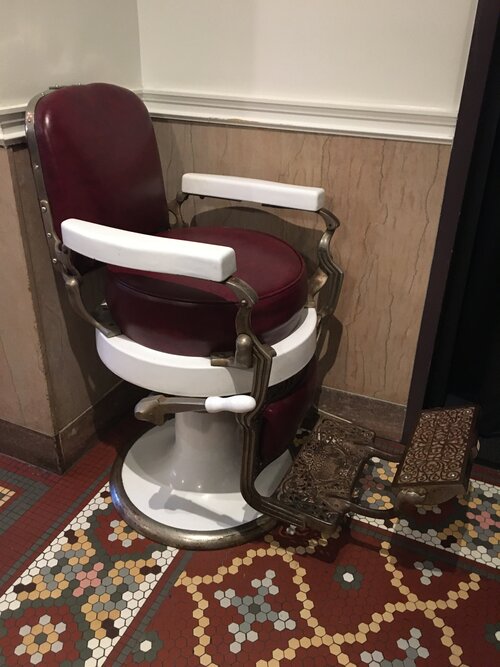
The factory later became a Panda Paints factory (1933). It is now an art gallery/space. This is of course American change. Some might say the presence of an art gallery in a post-industrial neighborhood is enough to tag a place gentrified. Maybe, but not in Fox Park…ever been to Koken Art Factory? Gentrification is not the right term for its latest use.
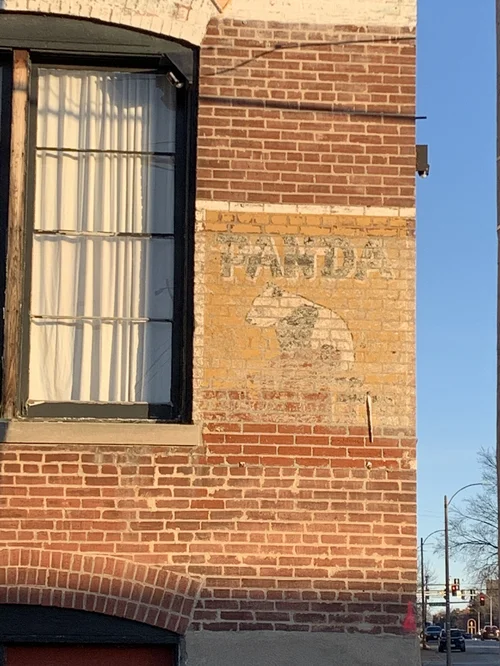
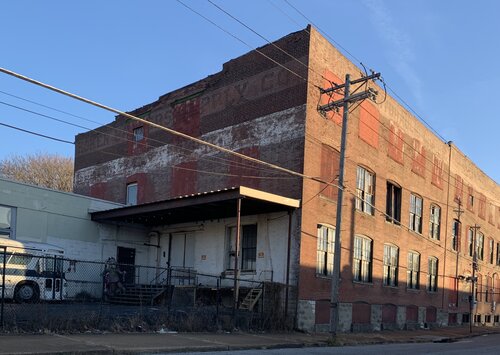
Chris told stories of people warning him about the paint huffers who worked at Panda Paints. They were the erratic ones that you were told to avoid. Toluene is an ingredient used in paint and thinners that gets you high, is addictive and can cause severe neurological damage. Chris said that even after the Panda Paint factory closed, there were a group of former employees who would still place orders for the toluene because they were so addicted. It became a business. They lived in and around Fox Park adding to the pastiche of street drugs and chaos of the times.
Chaos you ask? Chris described the rampant drug trade, mostly weed and smack, but then crack. Fox Park’s location right off of 1-44 at Jefferson made it a perfect drive through for suburban folk looking to score. Fox Park was known as an easy place to hook up. Chris described the clientele as “white boys from the county.”
Sometimes the deals would go bad and gunplay was common. Gunfire was still a regular thing when we moved here ten years ago. Not so much these days, when it is way more random and uncommon.
Drag racing was a thing too, in fact this is why there are medians on Russell Boulevard from Jefferson to Nebraska Avenue (the Fox Park section of Russell). This activity was not tolerated in Compton Heights on the other side of Nebraska. Fox Park was game; it’s easy to see how lines are drawn and this or that are or are not deemed acceptable.
Chris worked the second shift at McDonnell Douglas and on his way home would get waved down by the drive thru dealers offering up anything and everything. “Nah man, I live here.”
There was a system. Quick and easy, in and out, back to the burbs in no time. No muss no fuss. Police were okay as long as Soulard and Compton Heights people didn’t complain too much.
Russell Boulevard has drastically changed since the neighborhood’s tougher days. Ever see those beautiful townhomes between California and Jefferson?
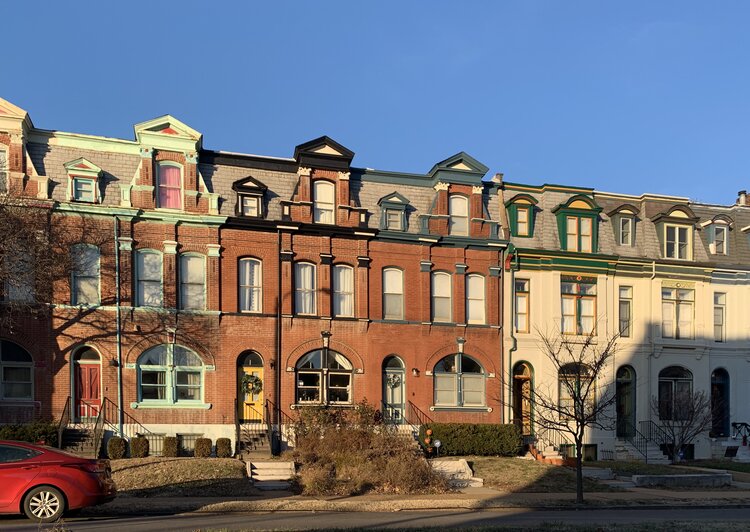
Chris remembers when those used to be boarding houses, crowded with poor/working class people. Now you see these homes on tee-shirts boasting Fox Park pride and beauty. They didn’t used to be like that.
Not just Russell Boulevard, the entire neighborhood was drastically different then.
The nearby public housing towers of Darst Webbe had recently been condemned and the people living there found housing in McKinley Heights and Fox Park, etc. The neighborhood back then was decidedly mixed with blacks and whites. The working class hoosiers now had some new friends and while racism is always an undercurrent, folks for the most part got along and partied together side by side.
Keggers on the front porch, drugs in the living room type of thing.
Most people were poor. Chris described them as very poor.
The grand homes on Russell and the surrounding streets nearly fell to the elements and scavenging at the time. Neighbors would walk right into the abandoned homes and tear out flooring, moulding, anything that would burn to heat their homes. Ceilings were falling down, it was a mess. This was common on Allen, Ann, Russell everywhere you went the abandonment and neglect was in your face and people still living there were picking the abandoned places apart.
The neighborhood was nearly destroyed from within. Home ownership wasn’t the prevalent mindset at that time.
Chris said, “In the 1970s/80s there was that typical South City mentality where you rent your whole life and everything would be just fine. People never dreamed or thought it an option to buy a home. They were too poor. Retirement? Investment? No, none of that, it was just getting by.”
“A family of six would live in a one bedroom apartment for $60 a month their whole life.” His rent raised from $60 to $100 and that’s when he decided to make an offer on the building. He bought the building and has stayed ever since.
He recalls rents rising in the 1990s.
“My main motivation was to not have to spend more money. I just wanted to quit moving. Buying my home was a good decision, I got lucky.”
“If you owned, you stayed or cashed out. If you were renting, you moved if you couldn’t afford it. It was mixed white and black, it was not a race issue.” One of the families who were known for drug dealing stayed. They paid off their home and eventually donated it to a church.
Chris believes more people were displaced due to neglect and falling properties than the city moving people out or new people displacing long time residents.
In the 1980s, Fox Park was interracial for sure. Few were investing in their property at that time, it was pretty shitty. People were partying together and living side by side. There is a family (name I will withhold) who were known dealers/connections. They are documented in “The Divided City” by Alan Mallach. There where white families just like these black families who were running illegal games.
Sometime in the mid to late 1990s things started to change. First there were gay men and women coming to the neighborhood, living in and rehabbing the buildings. They saw the tarnished beauty and were investing time, effort, love and money into the neighborhood.
Chris said some of the biggest changes were around the park. A former IGA (and other iterations) had a surface parking lot and pay phones that were places to score.
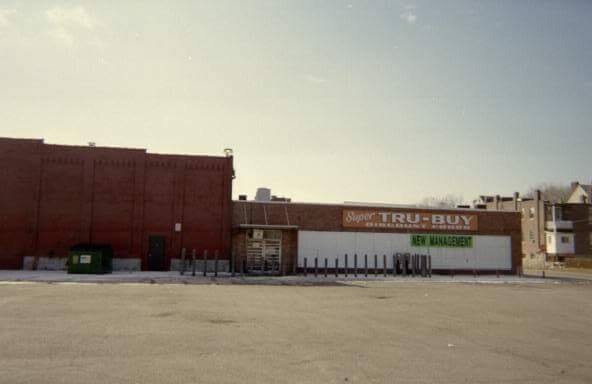
It became violent and the folks living on the up and up had had enough. There was pressure to tear it down, the powers that be intervened and made it so. A park committee was formed and what now is a general sports area was filled in with chat and debris from the demo’d grocery store.
Dirt was later hauled in, grass was planted, many years later trees, landscaping and signage were added. The local Community Development Corporation (CDC), DeSales has built up a pretty amazing youth sports league that uses the field.
Chris said he never thought this kind of positive use was possible just ten or fifteen years ago. The park was a decidedly negative place.
“Now I’ve been to sports events, concerts in the park and other gatherings. The park isn’t good if no one uses it. Now it is active and safe and decent. I didn’t have that growing up. The park wasn’t used at all in the old days for normal park uses, just for partying and dealing.”
Things really started to swing toward neighborhood involvement and improvement in the 1990s and early 2000s.
A morning glory garden went in at California and Russell in the old gas station. The old car lot across the street became a community garden, now called the Fox Park Farm. Personally, I’ve seen this place evolve in my ten years here, it is now a well cared for, busy place. There are apple trees and a gazebo/pergola type area that is a quite peaceful place to hang out.
Chris went through a divorce in 2001 and in 2002 he decided to channel some time toward neighborhood positivity by joining the Fox Park Park Committee. He met some of the first people who cared and wanted to make Fox Park a livable, dignified place. Some are still active in neighborhood improvement endeavors, as was Chris until just recently.
Chris has seen the change occur in multiple waves. But a sea change in the park took place in the early 2000s. A small group of people formed a park committee. The next leader, a personal friend of both of ours, took it over, and was able to bring tremendous change.
Today, Fox Park is quiet and folks who’ve owned property here for years are experiencing massive increases in property values. But to some this is not a blessing as the appraisers and assessors are taking notice and ensuring that taxes are collected to the modern tune.
Taxes have skyrocketed in Fox Park and this is a real concern for Chris who is on a fixed income now that he’s retired. “I’m talking $300 – $2,200 in a period of just a few years.” This is not abatements and the like expiring, this is the appraisals increasing and the taxman figuring it out and charging the people who once lived on the dime into a whole new world.
We have personally experienced this thing first hand as well. We accept it, but it is definitely a bitter pill to swallow and makes you recalculate all the family finances.
Per Chris, “People like me could get gentrified out of a neighborhood.”
Rising taxes are a sign of the times. We have to pay for our schools and services, I get it. But, the rate in which the increases came were fast and sudden for many. And of course, when a landlord renting a property experiences these increases, guess what happens to the rents?
Yet, he has no resentment or ill-will toward the change he’s experienced. He feels like he was part of it, in some ways. He worked hard to make the place dignified and welcoming to new comers.
The rewards overwhelm the property tax increases. And the place is good and the people are kind.
“You get to know your neighbors here; people are cool.”
“The new comers might have more money but they are not like rich jerks.”
“I don’t feel outclassed here, everyone is good to me.”
“You can be marginalized though. If you don’t pay property taxes, you might feel less interested in participating. You might not feel part of decisions or projects, but that is a choice. You don’t get pushed out, or talked over or ostracized. If you are human and kind, people embrace you. You will be welcomed and respected.”
I’ll return to the question, is Fox Park gentrified?
Ask yourself, if you are the socially conscious/sensitive type, what neighborhood is better and more livable and sustainable: the Fox Park that nearly met its demise of full on abandonment and social decay in the 1980s/90s or the Fox Park of today?
Per Chris, “The unimproved housing with the leaky roofs, rattling windows, ancient heating and very affordable rents is where I lived for years and what attracted me to this neighborhood. My neighbors found me odd but accepted me with all my faults. Nobody is perfect. These buildings are are being bought, rehabbed and sold. The occupants that could just barely afford the rent can no longer afford to live in an updated building. Where do they go to live? I don’t have the answer to that.”
“Change is taking place here, but I think most people would say “great”. It was saved from the cliff of abandonment and is a welcoming, good place to live. It is mixed income and race.”
But will it stay that way?
Next, we’ll talk to DeSales Community Development who have been working on neighborhood stabilization and dignified, affordable housing in Fox Park and other neighborhoods for many years. Without an active CDC working toward rehabbing and retaining and maintaining affordable housing, I don’t see how a neighborhood can stay mixed income and balanced rental/owner in a hot housing market that even St. Louis is experiencing in some neighborhoods, Fox Park being one of them.
Stay tuned, thanks for reading and caring. Be wary of the online social media echo chamber who rail against change in any form. To some, investment of any kind is displacing those who came before. I’m not there as of today, who knows where I’ll be in ten more years. Think for yourself, live in place before you judge it from behind a screen with realtor/sales/consumer data. Form your own opinions and most of all, talk to those who have more experience than you.
Ask yourself what you want your street, your neighborhood, your city to look like in ten years, and set a simple goal toward being part of that change. Believe it or not, change is good, St. Louis.
Whether you define the good ole days as 1990, 1970, 1950 or 1870, you can’t change the past. You can, however, be part of a just, amazing city in the present or near future.
Do it, move here, get it. Make it happen. You have the power to do it, just show up at the table, fight, work hard and be kind. You can do it all and make it so against the staid power structure.
Thanks to Chris for being a friend and helping widen my historical perspective on what came before in my neighborhood of ten years.

